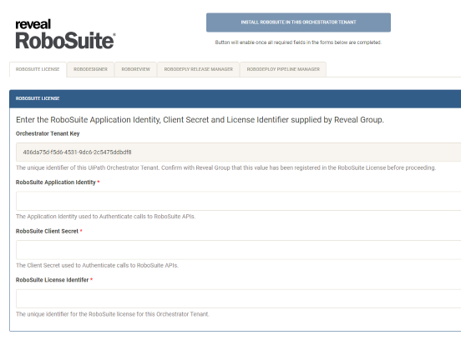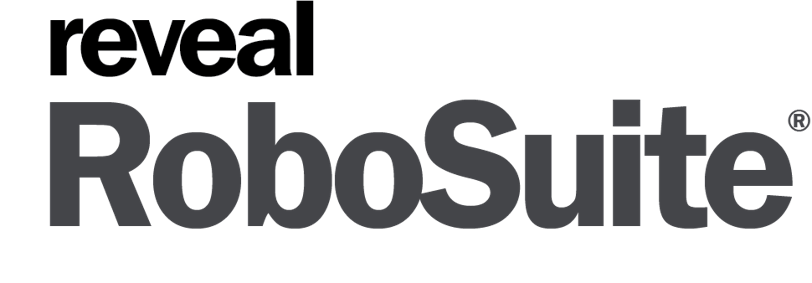
How to Install RoboSuite® for UiPath
Compatibility Matrix.
RoboSuite® for UiPath is compatible with most Mainstream Support versions of UiPath and supports limited use in Extended Support versions.
| UiPath Version | Support Status | RoboDesigner PDI Import | RoboDesigner Snippets | RoboReview Code Review | RoboReview Review Reporting | RoboReview CLI | RoboDeploy Configuration Manager | RoboDeploy Release Train | RoboDeploy Release Manager | RoboDeploy Pipeline Manager |
|---|---|---|---|---|---|---|---|---|---|---|
| 20.10 | Extended | Yes | No | Yes | No | Yes | No | No | No | No |
| 21.04 | Main Stream | Yes | Yes | Yes | No | Yes | Yes | Yes | Yes | Yes (Optional) |
| 21.10 | Main Stream | Yes | Yes | Yes | Yes | Yes | Yes | Yes | Yes | Yes (Optional) |
| 22.04 | Main Stream | Yes | Yes | Yes | Yes | Yes | Yes | Yes | Yes | Yes (Optional) |
- The RoboSuite® team will enhance, patch and support RoboSuite® on UiPath Mainstream Support Versions.
- The RoboSuite® team will provide limited support for RoboSuite® on UiPath Extended Support Versions.
Prerequisites for installation.
A Reveal Group issued Application Credential.
An Application Identifier and Client Secret that is required to be entered in the RoboSuite® installation wizard. This credential is used to call the RoboSuite® Licensing API.
A RoboSuite® License for each Orchestrator Tenant
- The RoboSuite® License Identifier (a 16-digit number) is required to be entered in the RoboSuite® installation wizard.
- RoboSuite® is Licensed Per Orchestrator Tenant and per User/Robot. The RoboSuite® License is a floating user license, a user can activate their license on a single machine at a time, but can switch machines between uses.
- Each RoboSuite® product, RoboDesigner®, RoboReview® & RoboDeploy®, can be individually activated/deactivated via license configuration.
- By default, each User/Robot is auto registered in a RoboSuite® License when running a RoboSuite® product. This capability can be enabled/disabled via license configuration. When disabled, the manual pre-registration of each User/Robot in the license is required.
- No Personally Identifiable Information for a User/Robot is stored in the RoboSuite® License. RoboSuite® stores a combination of the Orchestrator Tenant unique identifier (GUID) and the User/Robot unique identifier (GUID). These GUID values require the client’s Orchestrator Tenant API to be convertible to usernames & email addresses etc.
- The Orchestrator Tenant Key (The unique GUID of each Orchestrator Tenant) must be stored in the RoboSuite License and is used in License Activation requests. The Tenant Key is obtained by calling the Orchestrator Tenant odata/Users/UiPath.Server.Configuration.OData.GetCurrentUser API endpoint. Refer to the Orchestrator Tenant /swagger/index.html#/Users/Users_GetCurrentUser for more detail. For ease of access, the RoboSuite Installation Process calls this API and displays the Tenant Key.
CONFIRM YOUR LICENSE IS CONFIGURED WITH THE TENANT KEY BEFORE INSTALLATION!
RoboSuite® Packages
RoboSuite® is a set of UiPath Studio Wizards and UiPath Processes accessed via UiPath Studio / UiPath Assistant and UiPath Orchestrator. RoboSuite® is packaged as a series of NuGet packages uploaded to the Orchestrator Tenant.
RoboSuite® supports multiple versions of UiPath and it is important to match the version of RoboSuite® with the in use version of UiPath Studio. RoboSuite® will not load in mismatched version scenarios
| UiPath Studio Version | RoboSuite® Version |
|---|---|
| 20.10.x.x | 2010.x.x.x |
| 21.4.x.x | 2104.x.x.x |
| 21.10.x.x | 2110.x.x.x |
| 22.04.x.x | 2204.x.x.x |
RoboSuite®Version Numbers are structured as [UiPath Major Version].[RoboSuite Major Version].[RoboSuite Minor Version].[RoboSuite Patch]
Pre-Release Version Numbers are structured as [UiPath Major Version].[RoboSuite Major Version].[RoboSuite Minor Version]-[Pre-Release Tag].[RoboSuite Patch]
NOTE: Pre-Release Versions of RoboSuite® utilise staging infrastructure, which requires a separate Application Credential for use. An Orchestrator tenant and its Robots can only run one type of Release Version at a time.
Installation Wizard
Once all RoboSuite® Library and Process packages have been uploaded to the Orchestrator Tenant.
-
Create a Process from the RoboDeploy.Install package.
-
Run this process as an Attended Robot to access the RoboSuite® Installation Wizard.
NOTE: If you only have Non-Production or Unattended robots, RDP into the robot machine using the Robot’s service account to run the process.
-
Enter the RoboSuite® Application Credential and License Identifier supplied by Reveal Group.
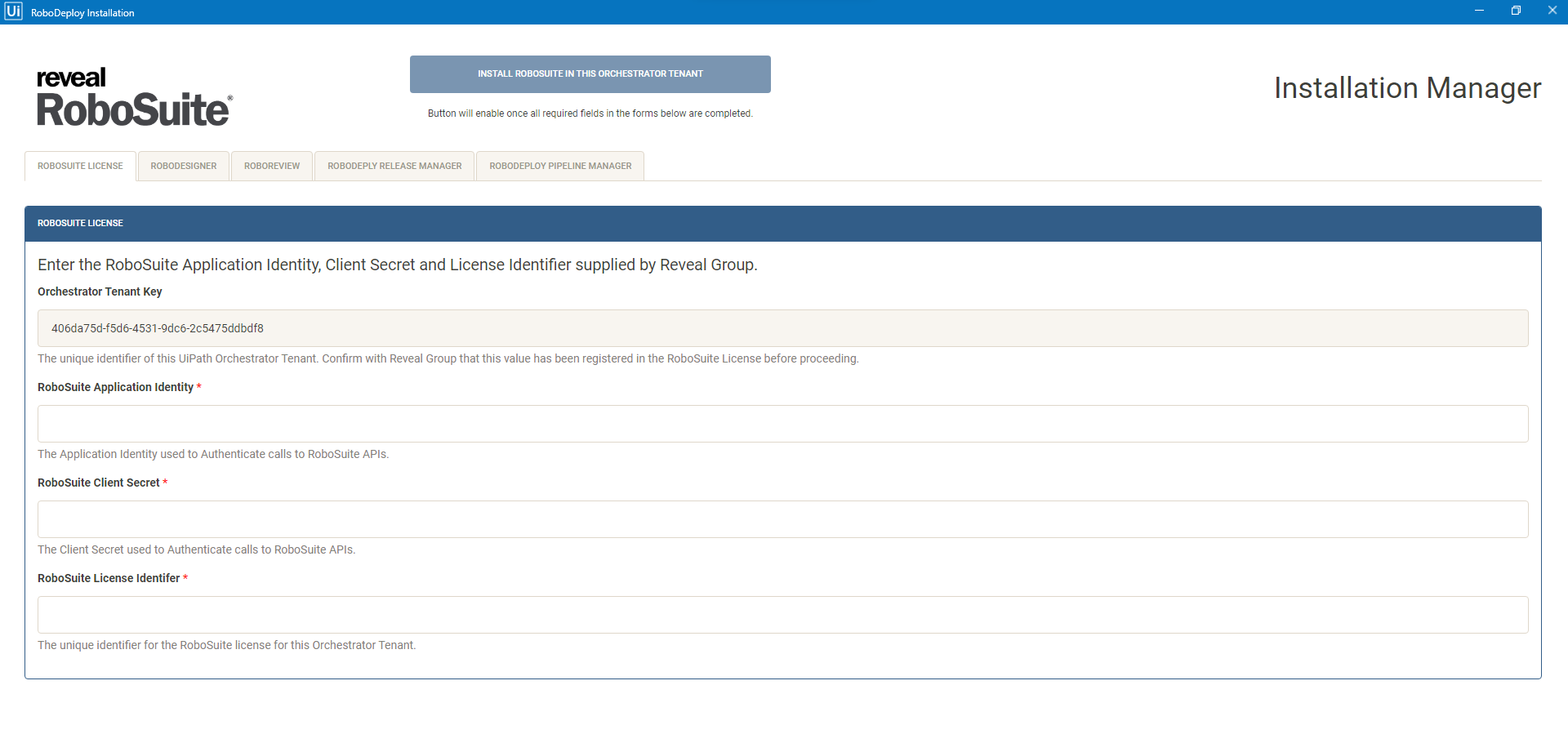
-
Select the Snippet Version that aligns with the version of UiPath.
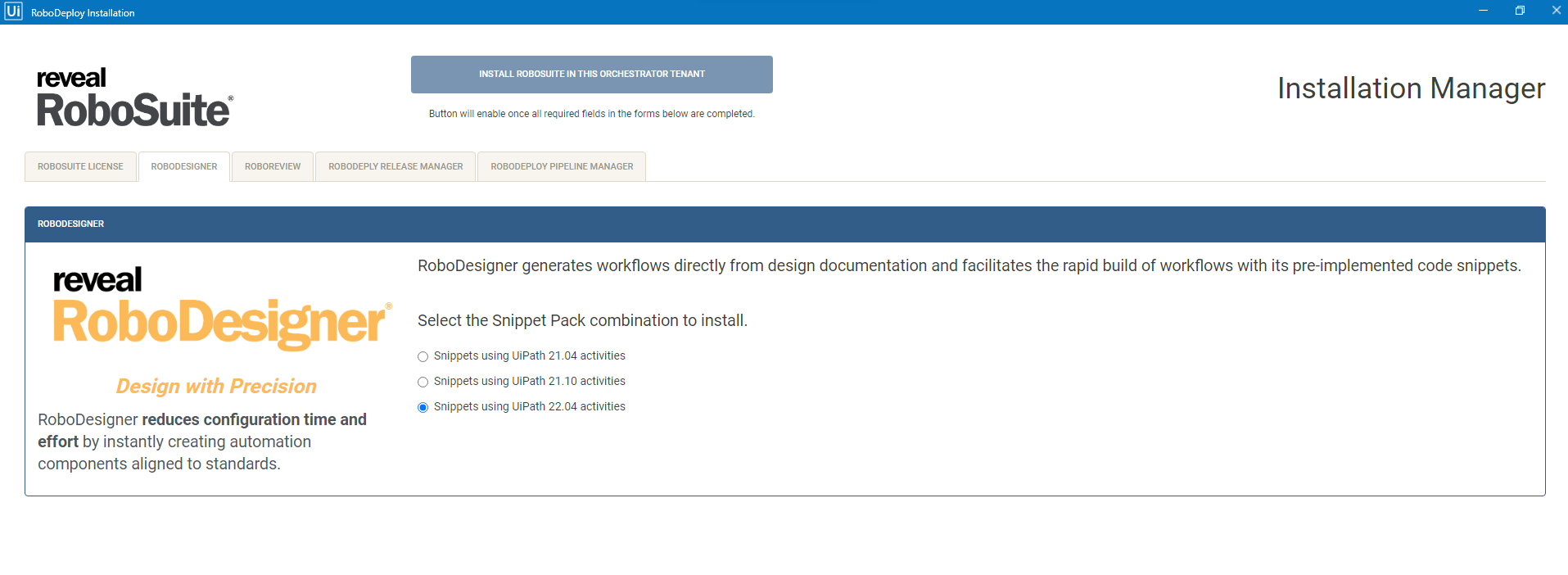
-
Specify the file path to the RoboReview SQLite database. Use a local file path if you want each developer to have their own dedicated database
e.g. C:\RoboSuite\RoboReview.dbor a UNC Network pathe.g. \\SERVER-1\RoboSuite\RoboReview.dbif a shared team database is desired.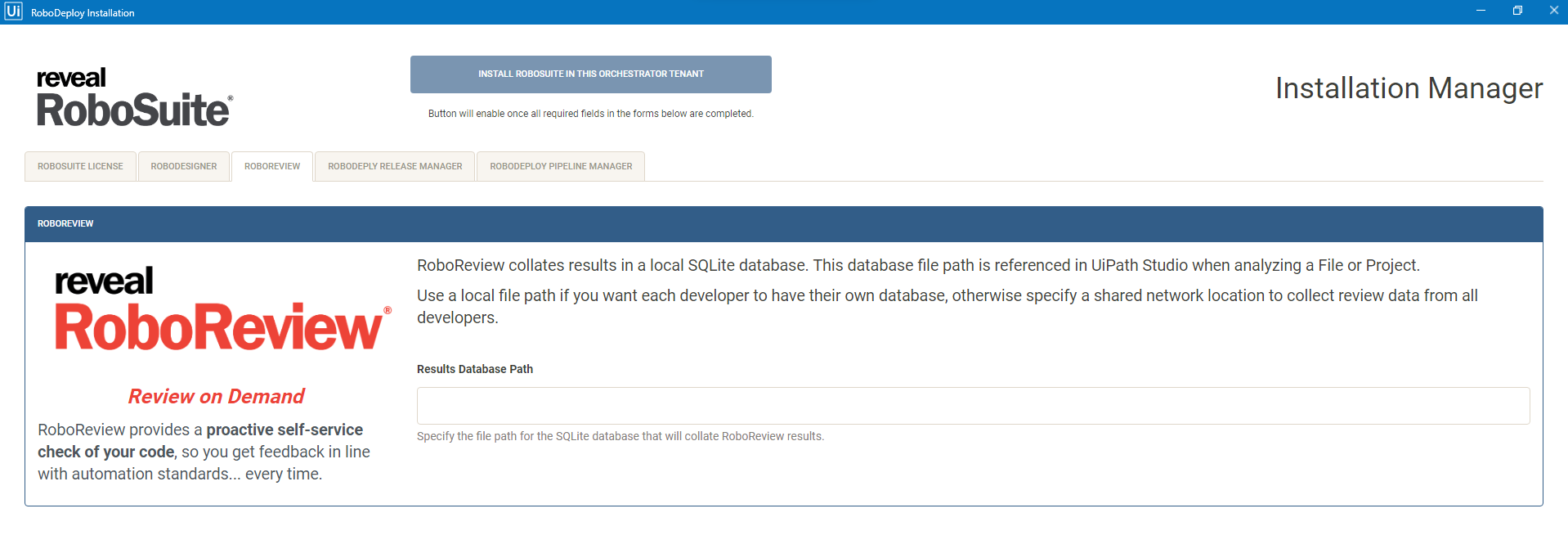
-
Follow the instructions to create an UiPath External Application and record its Application Identifier and Client Secret.
The UiPath External Application is used by RoboDeploy.ReleaseManager to connect with the Orchestrator API to provision Folders, Assets, Queues, Process and Triggers.
NOTE: You do not need to elevate the access of Users/Robots to deploy solutions using RoboDeploy®.
Specify the Default Storage Bucket name to be created for the RoboDeploy Agile Release Train. This is where packages awaiting deployment by RoboDeploy.ReleaseManager are uploaded.
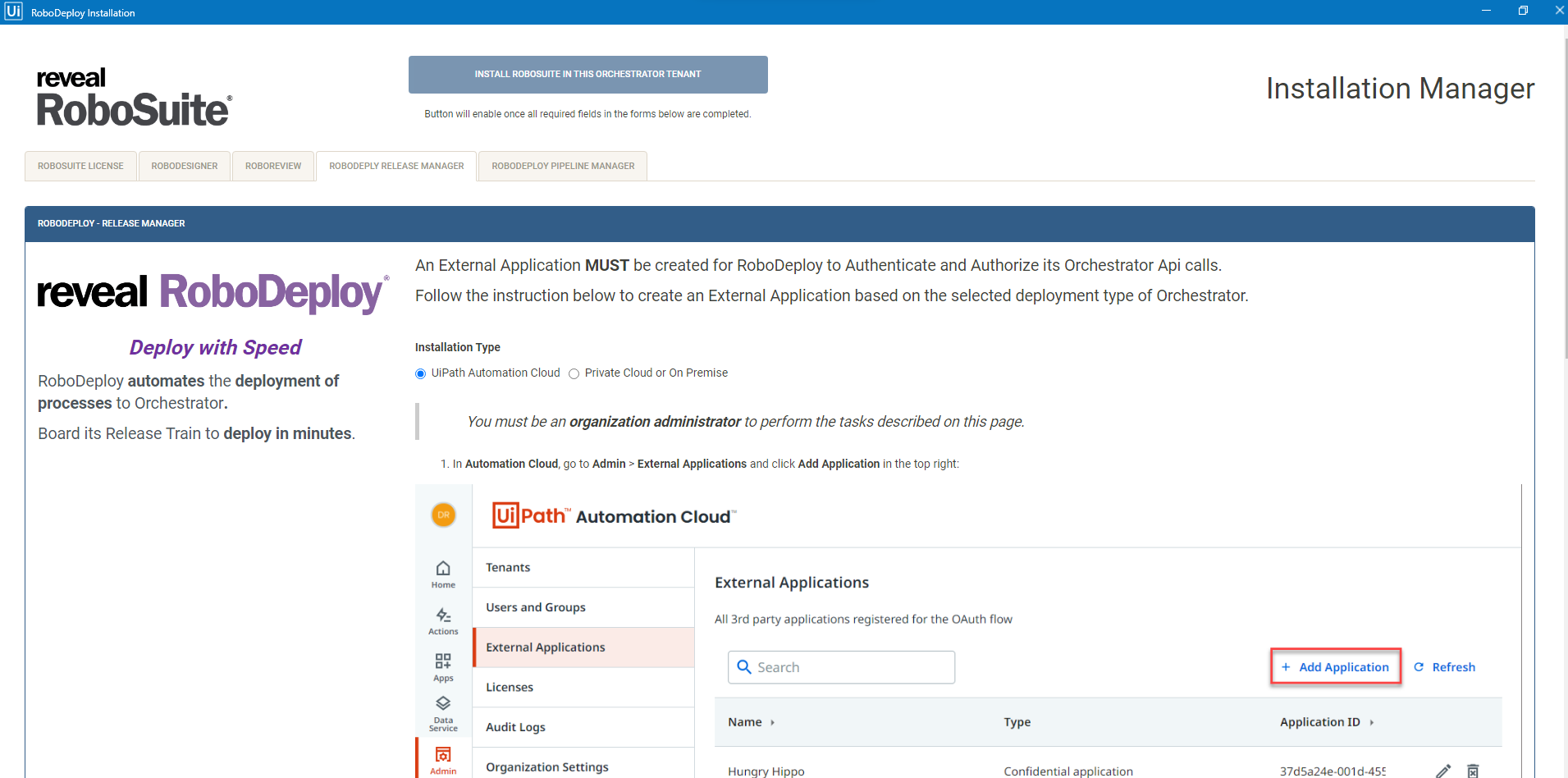 …
… 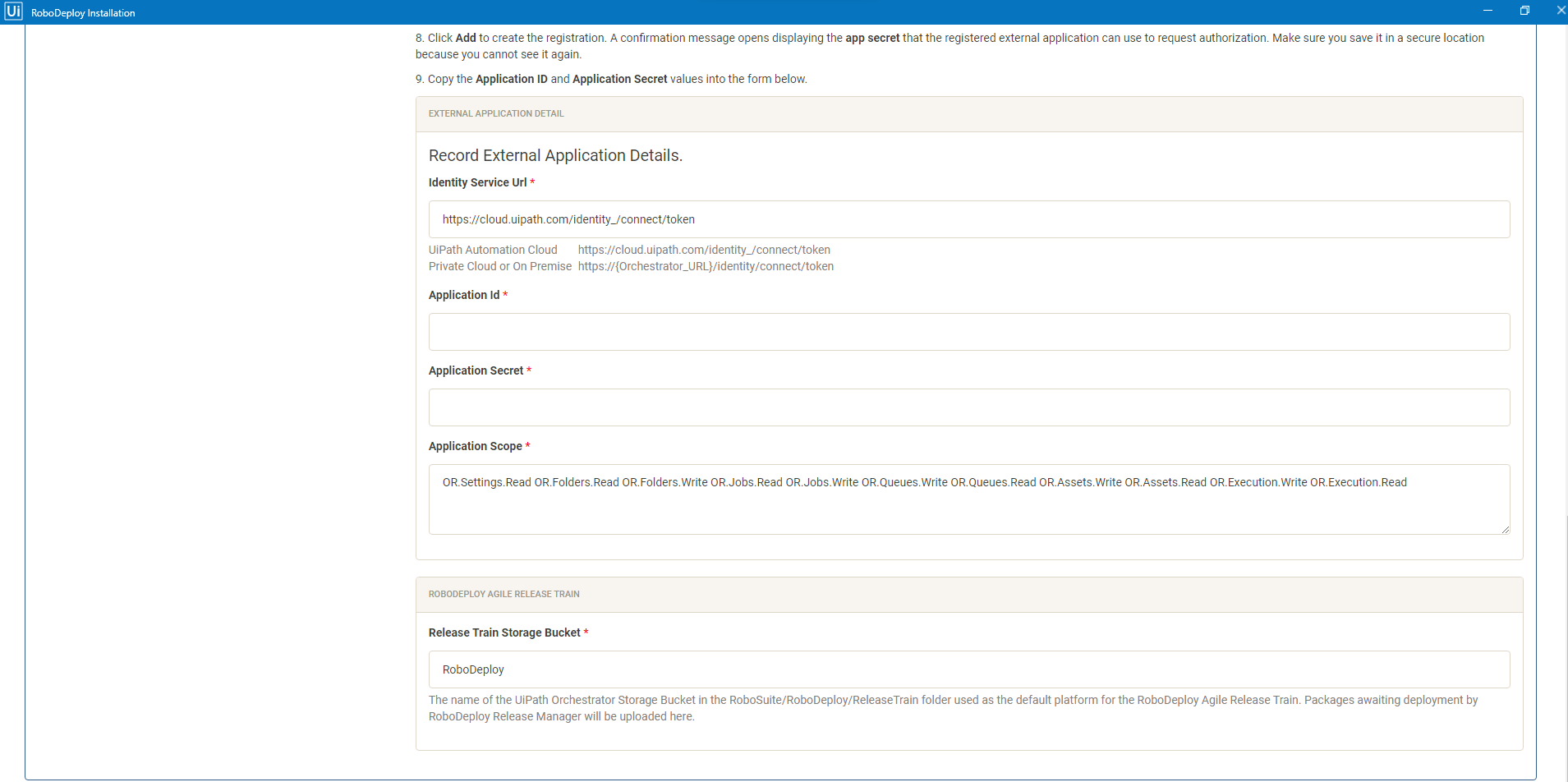
-
(OPTIONAL) Provide the Azure DevOps Organisation and Personal Access Tokens to install RoboDeploy.PipelineManager to be able to provision and configure DevOps projects.
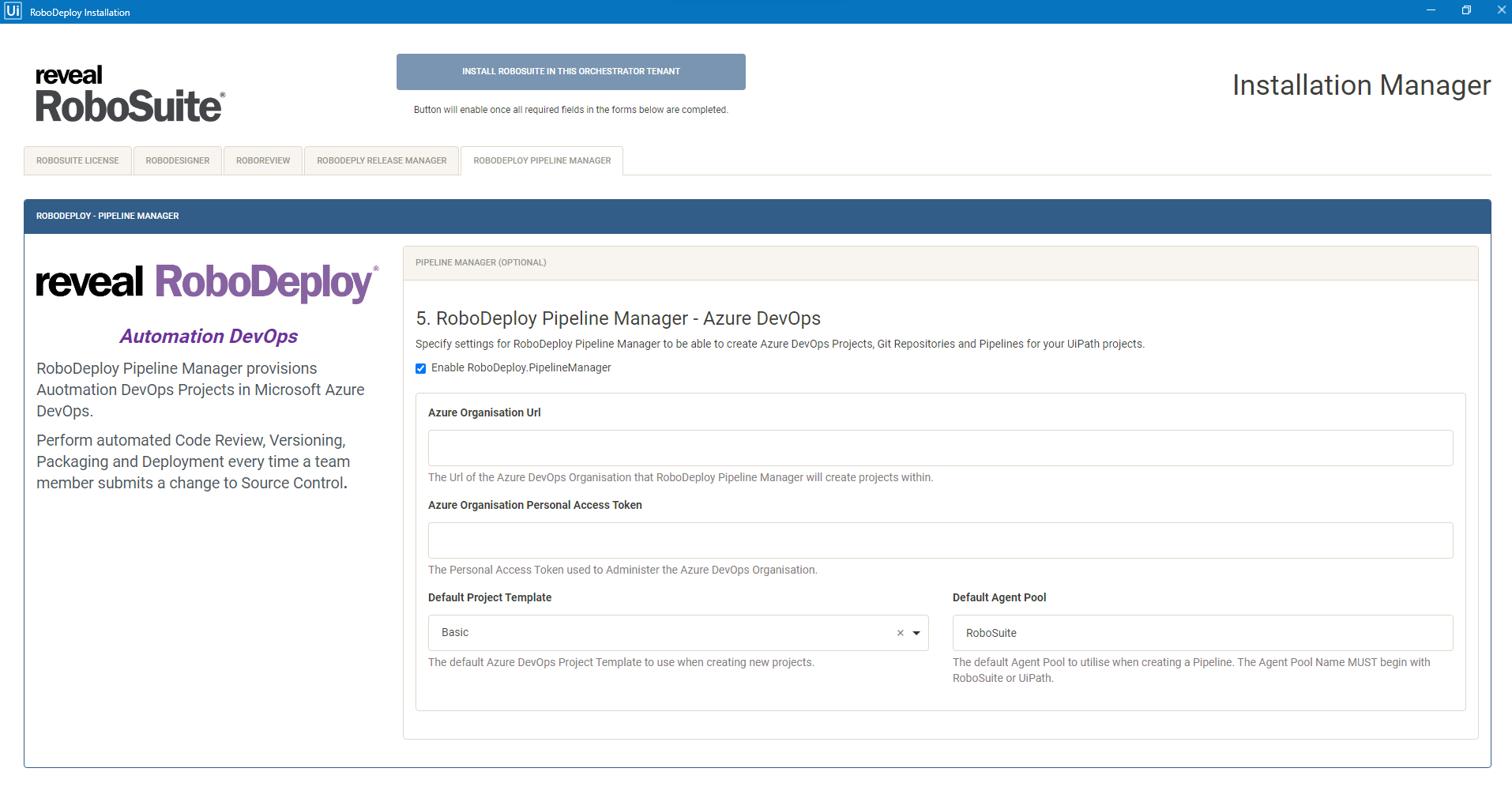
- Click the INSTALL ROBOSUITE IN THIS ORCHESTRATOR TENANT button.
The installation wizard will configure the Orchestrator Tenant creating a Folder Hierarchy to contain Process & Assets. A popup dialog will display the folder hierarchy once the installation is complete.
Modern Folder Hierarchy
To grant Users/Robots access to RoboSuite® functionality, simply grant them “Automation User” role access to folder.
| Modern Folder | Purpose | Who Should be Granted Access |
|---|---|---|
| RoboSuite | Root container of RoboSuite® functionality. | |
| RoboSuite/Common | Configuration and Process common to all RoboSuite® modules. | All Users |
| RoboSuite/RoboDesigner | Configuration and Process for RoboDesigner® Snippet deployment. | Development/Operational Users |
| RoboSuite/RoboReview | Configuration and Process for RoboReview®Code Review Reporting. | Development/Operational Users |
| RoboSuite/RoboDeploy | Container of RoboDeploy® functionality. | |
| RoboSuite/RoboDeploy/ConfigurationManager | Process to configure projects. | Development/Operational Users |
| RoboSuite/RoboDeploy/ReleaseManager | Configuration and Process to deploy process packages to Orchestrator. | Team Leaders & Tenant Admins |
| RoboSuite/RoboDeploy/ReleaseTrain | Process to upload packages awaiting deployment. | Development/Operational Users |
| RoboSuite/RoboDeploy/PipelineManager | Process to provision Azure DevOps workspaces for UiPath projects. | Team Leaders |
Adding RoboSuite® to UiPath Studio
Simply add a package reference to the appropriate RevealGroup.RoboSuite version in your UiPath project to include RoboSuite® wizards in UiPath Studio.
NOTE: Reveal Group Project Templates loaded as part of RoboSuite®, already have this package reference, any project created from the template will have RoboSuite® enabled by default.

